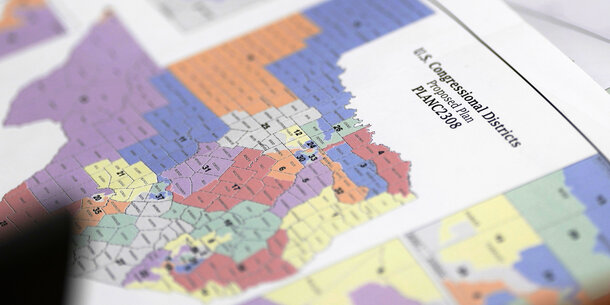The 2020 census aimed to count everyone residing in the country “once, only once, and in the right place.” It did not succeed.
Even as the Census Bureau touted the accuracy of its overall national population total, its main quality check showed that it reached that number by overcounting some groups and significantly undercounting others. These shortcomings in the count compromise the census’s ability to fulfill its core purposes of allocating political representation and funding to everyone according to their fair share. And they show that the only path to true census accuracy is census equity. The Census Bureau must put equity at the forefront of its plans as it begins to prepare for — and improve — the next census.
The bureau’s primary tool for evaluating how well the decennial census counted the country found that the 2020 census got the national population exactly right. At least, statistically speaking — its estimate of a “net coverage error” of –0.24 percent with a standard error of 0.25 percent basically amounts to zero statistical error.
Accurately gauging a population of some 331 million people is no small feat. But little turns on the national headcount. More important is how well the census counts specific states and specific communities. Seats in the House of Representatives are divvied up among the 50 states based on their relative population sizes. Redistricting allocates seats in state legislatures among communities in much the same way, with district boundaries drawn based in part on where populations increased or decreased. And the size and characteristics of specific communities help determine the funding they’re allocated for many critical federal programs, such as Medicare and food assistance. In Fiscal Year 2017, for example, over 300 federal programs used data derived from the 2010 census to distribute over $1.5 trillion dollars throughout the country.
When we drill down, we can see the census is coming up short where it matters most. The bureau’s topline figures obscure troubling inaccuracies spread unevenly across the country’s population on class and racial lines. Such inaccuracies produce serious concerns about the equity of both the count and everything that flows from it.
Black people were undercounted by 3.3 percent. Latino people were undercounted by 4.99 percent — a staggering increase from the 1.54 percent undercount in 2010. Indigenous people living on reservations were undercounted by 5.64 percent. And children under the age of five had a worse undercount rate in 2020 than any of the preceding five censuses. Ultimately, 18.8 million people were omitted from the 2020 census.
Meanwhile, the overcount of white people increased from 0.83 percent in 2010 to 1.64 percent in 2020, and Asian people went from no undercount or overcount in 2010 to a 2.62 percent overcount in 2020. Homeowners too were overcounted by 0.43 percent, but renters were undercounted by 1.48 percent. These are among the main areas of inaccuracy. And they added up to statistically significant undercounts in six states — Arkansas, Florida, Illinois, Mississippi, Tennessee, and Texas — and overcounts in Delaware, Hawaii, Massachusetts, Minnesota, New York, Ohio, Rhode Island, Utah, and Puerto Rico.
Numbers like these produce inequitable distributions of political power and federal funding, reinforcing societal inequality and undermining the census’s core purposes. When groups are statistically invisible, we are all worse off. Undercounted states can lose out on congressional representation. The undercounted parts of those states can lose representation within their state legislatures. And whole communities lose out on much-needed financial assistance and resources. States and communities getting more accurate tallies will require surmounting these inequities in how people are counted. Practically and statistically speaking, everyone’s fates are bound up together.
Both Congress and the Census Bureau are scrutinizing how to improve the count going forward. Centering equity in future reforms will be key to producing the census our democracy demands. We recently released Improving the Census: Legal and Policy Reforms for a More Accurate, Equitable, and Legitimate Count, a report that proposes how to reach this goal.
Congress can revoke statutory limits on how the bureau collects data so that it has the methodological flexibility it needs to do so more accurately. For example, experts like the National Research Council concluded decades ago that reducing differential undercounts requires the use of a statistical method called sampling. But sampling has been legally banned for apportionment purposes for decades.
Congress can also permit the Census Bureau director to extend the deadlines for completing the census during emergencies so the bureau has time to respond to any future disasters. Allowing the bureau to take the time it needs to complete its extensive door-knocking operation is especially critical for ensuring equitable data: that operation is “entirely about hard-to-count populations,” including people of color, low-income people, and young children.
Congress can also allow the bureau more freedom to collect data from educational institutions so that it faces fewer difficulties enumerating college students. Current restrictions make it challenging for the bureau to obtain students’ demographic information, potentially distorting the resulting data sets.
Congress can also facilitate changes to how the bureau asks about race, ethnicity, sexual orientation, and gender so that the census questionnaire yields more accurate data. And Congress can convene a National Academies panel to evaluate additional operational changes to eliminate persistent differential undercounts.
The census is foundational for democracy, but these errors are cracks in the foundation on which a just society is built. Accuracy and equity are inseparable. We can’t have one without the other. With planning for the 2030 census already underway, Congress and the Census Bureau must begin implementing reforms that will produce more equitable results. Census data serves none of us unless it looks like all of us.



